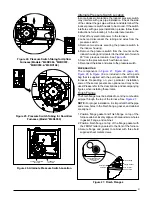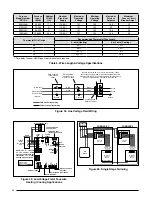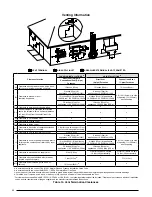
34
OPERATING SEQUENCE
The operating sequences for the heating, cooling, and
fan modes are described below. Refer to the field and
furnace wiring diagrams:
Heating Cycle
1. The thermostat calls for heat by energizing the W
terminal with 24VAC.
2. The control verifies the pressure switch is open.
3. If the pressure switch is open, the control energizes
the inducer and waits for the pressure switch to close.
The pressure switch must close within 10 seconds.
4. The inducer runs for a 30 second pre-purge.
5. The control energizes the Hot Surface Igniter (HSI)
output for the appropriate warm-up time limit.
6. The main gas valve energizes for 3 seconds.
7. If the flame proved and ignites the gas, the control de-
energizes the HSI. The gas valve and inducer remains
energized. The control goes to blower on delay.
8. If flame is present, the control energizes the blower on
the selected HEAT speed 30 seconds after the gas valve
opened. The gas valve and inducer remain energized.
9. When the thermostat demand for heat is satisfied, the
control de-energizes the gas valve. The Inducer output
remains on for a 30 second post-purge period.
10.
Blower off timing begins when the thermostat is
satisfied. The control will operate at the selected HEAT
speed of 60, 90, 120, or 180 seconds. If the blower
off delay jumper is not present, the fan should still
operate for 120 seconds at the selected HEAT speed.
The Indoor blower motor is de-energized after a blower
off delay as selected by the movable jumper.
Cooling Cycle
1. The thermostat calls for cooling by energizing the G &
Y terminals with 24VAC.
2. The control energizes the blower in cooling speed and
sends 24VAC to the contactor in the condensing unit.
3. When the thermostat removes the call for cooling, the
contactor in the outdoor condensing unit is de-energized
and the control continues to run the fan for a period of
60 seconds.
Fan Mode
• When the thermostat energizes the
G terminal for
continuous fan (without calling for heat or cooling), the
indoor fan is energized on the selected FAN speed.
• If a call for cooling occurs during continuous fan, the
blower will switch over to the selected COOL speed.
• If the
W terminal receives a call for heat during
continuous fan, the blower will de energize.
• A call for fan is ignored while in lockout.
Verifying Burner Operation
CAUTION:
The door over the burners may only be opened
for inspection purposes only. The door must be
installed during unattended operation.
1. Remove the burner compartment door.
2. Set the thermostat 5 degrees above room temperature
and observe the ignition sequence.
NOTE: The flame should carry over immediately between
all burners without lifting off, curling, or floating. The
flames should be blue, without yellow tips.
3. After validating the flame, change thermostat setting to
below room temperature.
4. Verify the burner flame is completely extinguished.
5. Replace the burner compartment door.
Verifying Operation of the Supply Air Limit
Switch
A properly functioning limit switch should turn off the gas
valve when the return is blocked (time depends on how
well the return air is blocked). The circulating air and
combustion blowers should continue to run when the
limit switch opens.
1. Verify the blower door is securely mounted in place and
that there is power to the furnace.
2. Block the return airflow to the furnace by installing a
close-off plate in place of or upstream of the filter(s).
3. Set the thermostat above room temperature and observe
the Operating Sequence.
4. Remove the close-off immediately after the limit switch
opens. If the furnace continues to operate with no return
air, set the thermostat below room temperature, shut off
the power to the furnace, and replace the limit switch.
Summary of Contents for M4RC-072D-35C
Page 47: ...47...















































